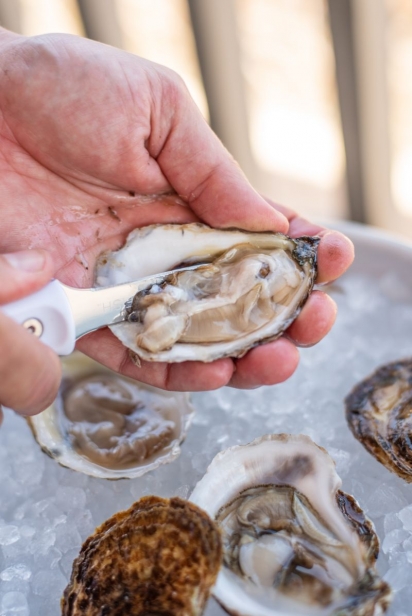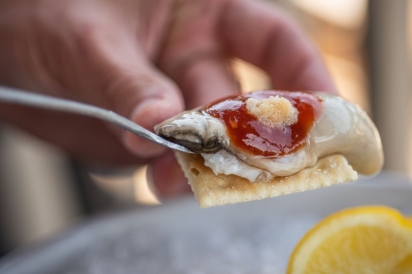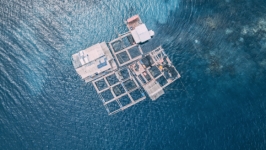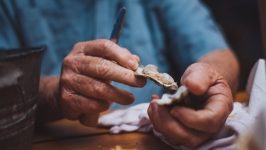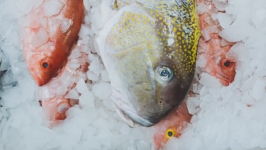Bivalve Aquaculture: A Case for Oyster Farming
Ask any resident of Northeast Florida about our local oysters and you’ll get a wide range of opinions. You may hear locals claim that they’re “best in the world,” extol plentiful, cheap steamed buckets from years past or praise the abundance of our local waters. Others, meanwhile, will tell you they only eat cold water oysters, or those from “back home,” i.e., the states north of North Carolina. I have heard almost every opinion about eating oysters, and I can tell you that I don’t agree with most of them. Nowadays we can eat oysters all year long thanks to modern refrigeration, seed selection and water quality testing. I know this all too well as the chef and owner of Boat Drinks, an oyster bar located in historic St. Augustine. I grew up here, and I am the first to admit that our local oysters could be better, a lot better. They could and should be farmed! Oyster farming is a relatively new, rapidly growing industry in Florida, but it's not a new concept. In fact, the practice of oyster farming dates to at least the ancient Romans. But farmed seafood is bad, right? In the case of oysters, this is one of the rare occurrences where the farmed product is better tasting, higher quality and more beneficial to the environment than the wild-harvested variety.
Oyster farming in Florida involves growing oysters from seed in bags or cages suspended in the water column. Since oysters are filter feeders, raising them off the bottom provides better access to phytoplankton and other small bits of algae. A full-grown oyster, which reaches harvest maturity in 6 to 18 months in Florida, can filter around 50 gallons of water per day while removing algal biomass, filtering silt, removing nitrogen for shell growth and depositing pseudofeces that become food for other organisms. Therefore, oysters can be a major part of the solution in cleaning up our waterways while also providing economic opportunities in aquaculture. This seems almost too good to be true.
So why isn’t anyone in Northeast Florida farming oysters? To help answer this question, I spoke with Cainnon Gregg, owner of Pelican Oyster Company in Spring Creek, Florida. Gregg was born and raised in Jacksonville but has been farming oysters in Florida’s Forgotten Coast since 2018 after leaving his art career behind. According to Gregg, the biggest barriers to entry in Northeast Florida are: (1) the cost of nominating a lease site as an Aquatic Use Zone (AUZ); (2) the lack of a local oyster hatchery; and (3) the fact that oyster farming requires physical work, mostly in and on the water.
Nominating an AUZ as an individual requires approvals from multiple governmental organizations; however, the state of Florida also could create AUZs, as they have done along Florida’s Forgotten Coast. In fact, the oyster industry is thriving in that region. that stretches the coastline along the Gulf of Mexico to the south-southwest of Tallahassee. Despite being a born and raised Floridian, I had to look up the area when I first heard the name Forgotten Coast; it comes from the exclusion of this region in most of Florida’s tourism promotions. It’s the proverbial no-man’s land of the Panhandle before you reach the high-rise condos, Spring Break beaches and uber-wealthy beach communities at the western end of the state. However, the Forgotten Coast is rich in relatively new oyster farms as well as in the storied history of oyster harvesting in Apalachicola, which is at the westernmost end of this region.
In the 19th and 20th centuries, oyster houses were a common sight in and around Jacksonville and the surrounding regions, as oysters were cheap and plentiful. Northeast Florida used to comprise the state’s second largest oyster harvesting region after Apalachicola. Oyster beds are still plentiful in this region, but they are not as robust or thriving as before. There are many factors that have contributed to this decline in the natural oyster reefs along with other marine life in Northeast Florida. While I applaud the efforts of organizations such as the Guana Tolomato Matanzas National Estuarine Research Reserve, who have multiple programs dedicated to oyster research, monitoring and shoreline restoration with oyster shells, I feel that a local oyster hatchery supporting local oyster farmers and their oyster efforts is the most direct solution.
Oyster farming is one of the most straightforward ways to rebuild our oyster population and marine ecosystem, given that every oyster seed we put back in the water is an additional one that wasn’t previously there. “Oysters are a keystone species,” says Gregg. “They are the beginning of the food chain.” Another added benefit is that the invertebrate marine life like shrimp, crabs, barnacles and others find new homes and protection amongst the floating bags of oysters, which then attracts fish like sheepshead, black drum, mullet and redfish. Oyster farming is net-positive for the environment as seed from the farmed oysters also finds its way to the natural oyster reefs.
Within the Northeast Florida region, only St. Johns County has an approved, albeit small, AUZ for shellfish, and it’s only being used for clams currently. However, there are a few marine regions that are open to wild oyster harvesting in St. Johns County. After a moratorium on shellfish harvesting in Duval County that has gone on for decades due to lack of water quality monitoring and questions about pollution levels, a section between Fort George and Big Talbot Island State Parks has recently been conditionally approved for shellfish harvesting. This seems promising for Duval, and I hope it is the first step forward. It is going to take more than the opening of small segments of waterways for shellfish harvesting in our region. In addition to developing an oyster farming industry, we need to educate local consumers about southern oysters, particularly the delicious, local resource that is Florida oysters.
I grew up along the banks of the Tolomato River in Vilano Beach, and I fondly recall eating grilled and steamed oysters that our neighbors would harvest across the river in their jon boat, as well as the big oyster roasts at the St. Augustine Boating Club across the street. When I was young, the preferred way to serve local oysters was cooked, and that preference persists today. At my oyster bar, we source farm raised oysters from multiple seafood suppliers; however, these vendors generally favor oysters from the northeast parts of the US and Canada. I am always pushing for more farmed oysters from Florida, and thankfully they are starting to become more accessible. Some of our most vocal oyster customers are the ones who swore they will only eat cold water oysters, and now they are asking what we have from Florida. We are in the middle of an oyster renaissance because of farmed oysters, especially oysters raised in the south.
The path to oyster farming in Northeast Florida isn’t going to be easy, but it’s not insurmountable. It is going to start with interested citizens and communities banding together and talking to our local and state representatives. Let’s bring the oyster industry back to our region. What’s the worst that can happen? More jobs, cleaner water and a stronger marine ecosystem? At the very least, maybe we’ll all have a chance to share some briny, plump, deep-cupped local oysters that just came out of our local waters.



